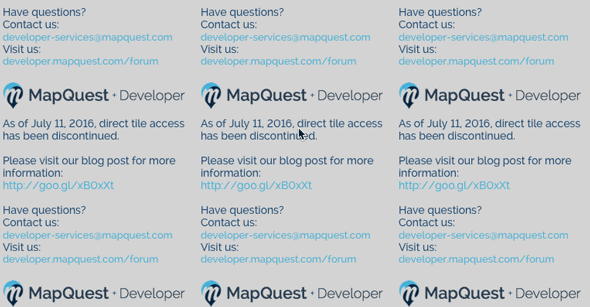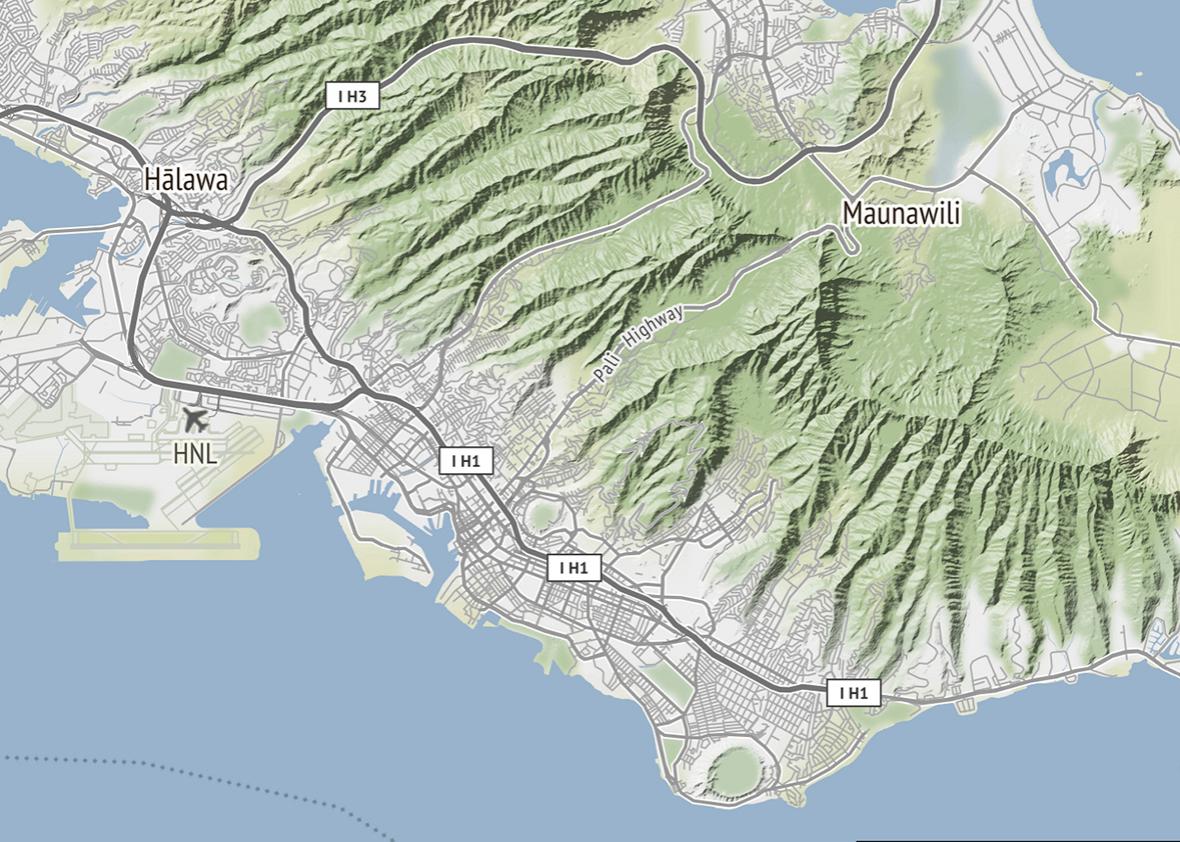On July 11, maps broke. In Eastern Spain, a developer raced to fix the social networking app he was working on before his next meeting with potential investors. In Oakland, California, another developer was trying to fix a site that helped people check how earthquake-resilient their homes are, after users tweeted that they relied on his now-broken map and could he please fix it!? In Sweden, a team reached out to other open-source developers for help getting their route-planning application back up and running. All at once, streets, highways, mountains, and oceans had blinked out of existence, replaced by an endlessly zoomable and repeating disclaimer: “Here be nothing.”

Mapzen
The maps didn’t exactly break, but the base maps that they were built on (served up by MapQuest as a “tile set”) had disappeared. After six years of hosting and maintaining this open base map of the world, MapQuest chose to retire it, releasing new and enhanced base maps in their place, which will require a MapQuest account and usage plan.
MapQuest tried hard to alert the mapping community of the impending change. But because users hadn’t been required to register, the company had no way to reach out to them directly. So many were caught by surprise, their projects broken and their users confused and unhappy. In a sense, a public resource had ben removed from the web.
For users, a change like this can be incredibly abrupt. A service like Foursquare (which runs on open map data) can be imagined sitting at the top of a kind of Jenga tower. If any of the tools or data sets that it depends on breaks or disappears, the whole tower above can crumble, hurting each program or site above it. But for developers, it doesn’t come as much as surprise; this chain of dependence is part of the world of open source. Randy Meech, the current CEO of Mapzen and someone who helped MapQuest build out its original open tile set, explained that these tile sets are enormous, and they require a lot of work to create and host. That they will continue doing so with no charge or restrictions is far from a guarantee. Companies can shutter or change their terms of use with little notice, taking their tools, data, and code with them. There is good news, though: The open-source community is incredibly resourceful—and designers and developers are already stepping in to fill the void left by MapQuest to offer beautiful tiles with absolutely no restriction on use.
But first: What exactly is a tile set? If you imagine a giant quilt that showed a map of the entire world, a tile set would be like a collection of 18-19 of these quilts, one for each zoom level. Zoom level zero would be a quilt with just a single “tile,” with the entire world on it. Each successive zoom level will require four times as many tiles to cover the Earth. (This is called a quadtree.) That might not sound like a lot, but when you get down to zoom level 18, a company like MapQuest could be serving up a quilt made up of more than 68 billion tiles … for free. That’s a lot of quilting. (Microsoft has a great, albeit more technical, explanation of tiles here.)
That’s not to mention the artistry and design work that goes into creating an elegant and useful tile set. Chris Whong, an open-source map developer and adjunct professor at NYU’s Wagner Graduate School of Public Service, says the creation of base maps is much more nuanced than many would think: “Mapping isn’t really choosing what to show, it’s choosing what not to show. For any given spot on the Earth, you have a million things that you can describe about that place, or about the things that are in it.”
For developers, coders, civic hackers, and tech entrepreneurs, these skillfully designed, open tiles sets are a massive gift, a free public resource upon which they can build all manner of tools and services. In a recent report for the Ford Foundation, Nadia Eghbal writes, “Much like roads or bridges, which anyone can walk or drive on, open-source code can be used by anyone—from companies to individuals—to build software.* This type of code makes up the digital infrastructure of our society today.”
Open-source maps are no exception. They power and undergird all kinds of tools that we use every day, from major sites like Foursquare and Craigslist to small startup projects. Most of them depend on free and open data, painstakingly collected by OpenStreetMap, a company and community that has built a free map of the world Wikipedia-style, through submissions, edits, and updates from volunteers around the world.
MapQuest does still offer a free option for people who want to use its tile set. “Although our legacy Open Tiles were discontinued, they were succeeded by additional tile sets that feature new styles available to our users,” writes MapQuest director of communications Leila Qualheim via email. “There are actually more choices available today to developers who would like to use our tiles within their applications.” If you want to use MapQuest’s tiles now, you have to sign up for an account; the free option includes up to 15,000 tile transactions per month. (Transactions are triggered by events like loading a map, changing zoom level, panning across the map, etc.) So if users averaged one pan and two changes in zoom level per visit, that is 125 free visits per month. For the creators of projects like Soft Story, Naitfy, GNOME Maps, and jQuery Geo, that didn’t seem like enough—they started shopping around for a new base map after MapQuest’s usage changes.
Luckily for them, new tile sets arrive where old ones disappear. On July 13, two days after direct access to MapQuest’s tiles ended, the internet got a new free map of the world, built and designed by Stamen, a small map-centric design firm based out of San Francisco. It just released a worldwide version of “Terrain,” its most recent contribution to a collection of beautiful open-source maps, which it offers up to the internet as free and unrestricted tile sets.

Stamen Design
For people like you and me, these tile sets are just fun to play with. With rich topographic contours and muted street grids, we get to see our childhood home or favorite city rendered in a new and beautiful way.

Stamen Design
But for developers, these tile sets are much more than gorgeous images. They keep our internet growing and our web maps functioning. That is, until they don’t.
There is no guarantee that Stamen’s new map of the world will be here or free and open forever. Though the company has a demonstrated a strong commitment to the world of open-source mapping, and is making all efforts to ensure these maps stay free for everyone, the truth is that maps of the world will come and go. But the open-source community will keep adapting, remaining nimble in order to keep on going. In the meantime, Stamen’s beautiful new maps are here—absolutely no strings attached.
*Correction, Aug. 11, 2016: This piece originally misspelled Nadia Eghbal’s last name. (Return.)
This article is part of Future Tense, a collaboration among Arizona State University, New America, and Slate. Future Tense explores the ways emerging technologies affect society, policy, and culture. To read more, follow us on Twitter and sign up for our weekly newsletter.
